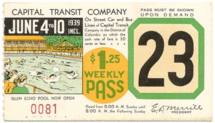Rethinking Metro’s passes, part 1: Passes today
Since Metro will now upgrade Smartrip to allow passes by mid-2010, there is now an opportunity to decide whether to keep the existing passes or develop a new system of passes.
Upgrading the SmarTrip software opens up new possibilities that were not feasible with the old token, paper pass and magnetic stripe card system, or with the old SmarTrip farecard system.
In the old days of streetcars, there was cash and weekly passes. Passes worked like the bus pass today: a rider showed it to the driver on entry. Here are some passes from 1933-1958; each was good for a certain week and often featured seasonal artwork. Of course, they did not require any equipment or “reader” to work.
Later, tokens made it convenient to pay amounts that would not be convenient with coins. They also allowed the transit agency a way to provide a discount to frequent riders, by selling multiple tokens at a time for less than face value.
Metrorail introduced the magnetic farecard, which allowed the system to deduct fares from a stored value based on the distance traveled and by time of day. Some magnetic farecards are passes, programmed to allow unlimited rides, and some of those farecards also had markings to serve as the same visually-verified bus passes. In the early 2000s, Metro eliminated this combination bus/rail pass.
We now have two weekly passes and one daily pass on Metrorail, and one weekly pass on Metrobus.
The unlimited Metrorail pass costs $39.00 per week. A short rail pass, which offers unlimited rail rides of less than $2.65, costs $26.40 per week, and riders have to use an Addfare machine and add exact change if a ride costs more. These passes are not very popular. According to data from Metro, less than 1% of rail trips are taken with each pass. The average rider with an unlimited (“fast pass”) uses it 11.4 times during a week, and a short rail pass holder uses that an average of 13.3 times.The one day rail pass ($7.80 and valid for unlimited rail trips except between opening and 9:30am on weekdays) constitutes about 0.6% of weekday riders and 4% of weekend riders. Each one gets used 2.6 times on average.
The unlimited Metrobus pass costs $11. Unlike the rail passes, this pass is fairly popular. About 21% of bus trips are taken with an unlimited bus pass, probably because it’s offered at a 12% discount to 10 single rides and eliminates the need to purchase a $5 SmarTrip card. On average, a bus pass is used 19 times per week (my calculation from Metro’s data), but that counts trips where a pass is used instead of a transfer.
None of the rail passes are valid for anything on bus or vice versa. Since the elimination of paper transfers also got rid of the transfer printing machines in Metrorail stations, there are no longer any transfer discounts from rail to bus for pass users.
Now that Metro is working on putting passes on SmarTrip cards, it gives us an opportunity to think about whether the current passes are adequate for Metro and the riders. In the next part, I’ll discuss why we have passes and the key requirements.


